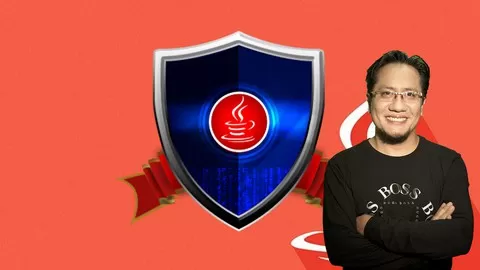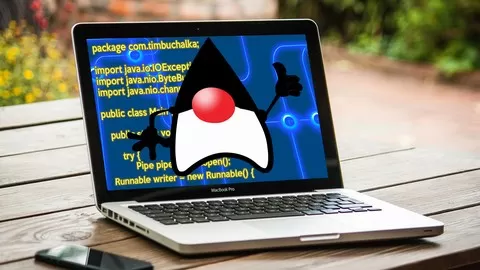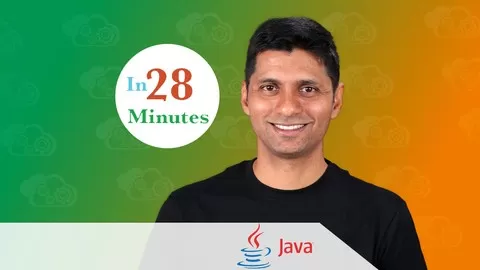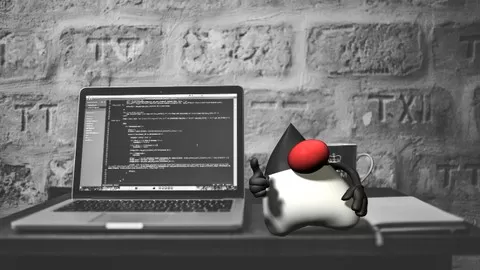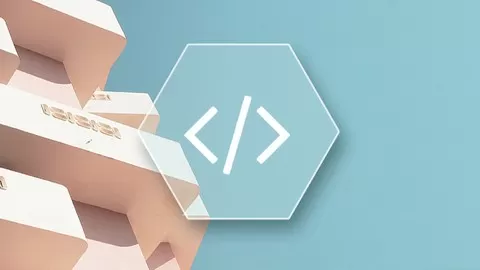‘+330 PDF (eBooks), + 22,500 students, + 300 reviews of very satisfied students, and the best HIGH PRIORITY Support for any doubt of your course, only for students enrolled in the course. YOU WILL NEVER BE ALONE. “The Java University is the best course to learn Java and now in English.”
The Java University course is already a Best Seller at UDEMY Spanish [Universidad Java], and NOW the Java University is also published in English. All the videos are in English and include subtitles (generated manually not automatically). And every Video has it’s corresponding PDF or eBook. So you can study Online or Offline. This is just great!!!
This course is a specialization in Java technology. We will start from the Java Fundamentals, and take you step by step to become a Java expert in record time and so you can create Web and Enterprise Java applications, including topics and technologies such as Java Basics, Object Oriented Programming (OOP), Design Patterns, JDBC, HTML, CSS and JavaScript, Servlets and JSPs, Struts Framework, Hibernate Framework, Spring Framework, Java Enterprise (Java EE now Jakarta EE), including EJB’s, JPA, Web Services, Security and much much more.
With all the above, you will have the bases to prepare several certifications as a Java programmer, in addition to acquiring the knowledge to be able to apply to several job vacancies to start working as a Java programmer in record time.
Java University has spent years in the market training Java professionals ready to enter the Java labor market. And now the Java University is at UDEMY to provide the full array of Java tools and technologies you need for the real world and professional Java.
This is the best Online course to learn Java. The content is divided into perfectly structured levels, each level supported by the previous one, with the aim of adding Java knowledge incrementally and so you can focus on mastering the issues little by little and gradually. So ensure the success of your Java training.
We will offer support of any doubt of the didactic material included in this Java specialization.
To make matters worse, we manage a new teaching methodology that we have called Speed Learning. This methodology consists of concise videos that go directly to the point to be studied, complemented by eBooks with explanations and step-by-step images (which you can print, or search for any text you need, or use for your offline study), since As we know we can not do text search within video. In addition, our methodology includes perfectly structured and very didactic exercises that will allow you to accelerate your eLearning learning. No loss of time in videos where you have to watch the instructor codify an exercise, too much theory, little practice or anything like that. Our Speed Learning methodology guarantees that in the shortest possible time you will acquire the necessary knowledge for the Java professional and working world.
The Java University includes the following topics of study in Java technology and related technologies:
Level 1. Java Fundamentals
Lesson 1 – Starting with Java Technology
The amazing world of Java programming
What is Java technology (from a practical approach)
Our first Java program from scratch
Lesson 2 – Variables and Operators in Java
Use of Variables in Java and what we use them for
Types of Data in Java and how they are classified
Management and Classification of operators in Java
Lesson 3 – Control statements in Java
Using the if-else structure and where to use it
Handling the switch structure and when applying it
Lesson 4 – Handling Cycles in Java
Use of the for cycle and its use
Using the while loop and how to apply it
Use of the do-while cycle and when to use it
Lesson 5 – Object Oriented Programming
Introduction to Object Oriented Programming (OOP)
Handling Classes in Java
Use of Objects in Java
Lesson 6 – Functions in Java
Declaration of Methods or Functions in Java
Use and call of functions in Java
Lesson 7 – Data Management in Java
Using Arrays in Java
Management of Matrices in Java
Lesson 8 – Inheritance in Java
Inheritance Management in Java
Use of superclasses and subclasses in Java
Final Level Laboratory
Final Exercise where everything learned in this Level is included
Level 2. Java Programming
Lesson 1 – Polymorphism in Java
What is polymorphism and its application
Overwriting in Java and its use
Lesson 2 – Advanced Object Management in Java
Conversion of Objects (cast)
Identifying the type of object with the instanceof operator
The importance and use of the operator this
Lesson 3 – Handling Code Blocks in Java
Scope of Variables (Scope)
Use of static and non-static blocks
Lesson 4 – Use of Abstract Classes and Interfaces in Java
Differences between Abstract Classes and Interfaces
Declaration and use of Abstract Classes
Handling Interfaces in Java and when to use them
Lesson 5 – Handling Exceptions in Java
Processing exceptions in Java
Use of try-catch and propagation of Exceptions
Module 6 – Manage Collections in Java
Using collections in Java
Management of List, Set and Map and the application of each structure
Module 7 – Handling Files in Java
Handling and using files in Java
Streams management in Java and its uses
Final Level Laboratory
Final Exercise where everything learned in this level is applied
Level 3. Connection to Databases with JDBC
Lesson 1 – Starting with JDBC (Java Database Connectivity)
The need for a database
Installing MySql and Oracle
Download drivers (drivers) to connect to the base
Lesson 2 – Connecting to the Database
Steps to connect to a relational database
JDBC code to connect to the database
Lesson 3 – Select Sentence
Steps to execute the SQL Select statement with JDBC
Using the select statement to read the information in the database
Lesson 4 – Manipulating Data with JDBC
Steps to execute the insert, update and delete statements
Use of insert, update and delete statements to manipulate information
Separation of functions select, insert, update and delete with JDBC
Lesson 5 – Metadata with JDBC
Knowing the structure of tables with JDBC
The importance of using metadata in JDBC
Lesson 6 – Oracle, Store Procedures and Functions
Java JDBC with Oracle
Execution of Oracle Store Procedures with JDBC
Execution of Oracle functions with JDBC
Lesson 7 – Multilayer Architecture
Structuring our JDBC code
Creating the data layer in a Multilayer Architectures
Lesson 8 – Design Patterns
DAO Design Pattern (Data Access Object)
Design Pattern DTO (Data Transfer Object) or VO (Value Object)
Final Laboratory with the integration of everything seen in this Level
Level 4 – HTML, CSS and JavaScript
Lesson 1 – Introduction to HTML
We will study an introduction to HTML technology
Understanding the role of HTML in the world of Web applications
Lesson 2 – Components in HTML
The HTML components and how a Web page is structured
Use of Text components, Fonts, Preformat and more in HTML
Lesson 3 – Introduction to CSS
Introduction to CSS Style Sheets
The most important aspects to consider when using CSS
Use of classes and identifiers in CSS
Lesson 4 – Forms in HTML
Elements to consider when creating HTML Forms
Components for the creation of HTML Forms
Lesson 5 – Introduction to JavaScript
What is JavaScript and how to apply it in our HTML pages
Basic elements of the JavaScript language
Lesson 6 – HTML Forms Validation
Integration of HTML and JavaScript Forms
Validation of Forms with JavaScript
Level 5 – Servlets and JSPs
Lesson 1 – Introduction to Web Technology with Java
The amazing world of Web technology with Java
The revolution of Web applications and how to take advantage of it
The Tomcat application server and how to use it
Lesson 2 – Basic Concepts of Servlets
No mysteries: what is the technology of Servlets
Elements and life cycle of a Servlet
Lesson 3 – Handling Sessions with Servlets
Implementation of the concept of Sessions with Servlets
We will learn the use of the HttpSession object
We will implement a shopping cart Web
Lesson 4 – Basic Concepts of the JSPs
We will study how to create dynamic Web pages with JSPs
We will learn the fundamental elements of the JSPs
Lesson 5 – Advanced Concepts of Servlets and JSPs
We will see how to create a Web application integrating Servlets and JSPs
Data processing with Servlets and information deployment with JSPs
Lesson 6 – JSTL and EL (Expression Language) in JSPs
We will understand the JSTL tags to facilitate the use of JSPs
We will see the power of EL (Expression Language) in the JSPs
Lesson 7 – MVC Design Pattern (Model View Controller)
We will study a multilayer architecture of the real world with Servlets and JSPs
We will apply the MVC design pattern with Servlets and JSPs
Lesson 8 – SMS Application (Student Management System)
Integration of the first 5 levels in a final project (SMS)
Analysis, Design and Development of the SMS application
This level allows them to get employment from scholarship or Java Junior programmer
Level 6 – Struts Framework
Lesson 1 – Introduction to Struts Framework
What is a Struts Framework?
Installation of Course Tools
Lesson 2 – Hello World with Struts
Creation of the Web project with Struts Framework
Hello World with Struts.
Lesson 3 – Actions Management with Struts
Actions with Struts
Exercise Actions with Struts
More Actions with Struts
Lesson 4 – Handling Forms with Struts
FormBeans with Struts
Exercise with FormBeans
Filling Forms with Struts
Lesson 5 – Advanced Actions with Struts
Advanced Forms with Struts
Exercise Advanced Forms with Struts
Lesson 6 – Internationalization with Struts
Internationalization Management with Struts
Exercise management of messages with Struts
Internationalization management exercise with Struts
Lesson 7 – Handling Exceptions with Struts
Management of Exceptions with Struts
Exercise Handling Exceptions with Struts
Lesson 8 – Manual Validation with Struts
Manual Validation with Struts
Exercise Manual Validation with Struts
Lesson 9 – Automatic Validation with Struts
Automatic Validation with Struts
Automatic Validation Exercise
Lesson 10 – Handling Tiles (Templates) with Struts
Use of Tiles (Templates) with Struts
Exercise Templates with Struts
Final Laboratory
Conclusion of the Course with Struts
Level 7 – Hibernate Framework and JPA (JavaPersistence API)
Lesson 1 – Introduction to Hibernate Framework
What is an ORM – Object Relational Mapping?
How Hibernate helps me in a multilayer business design
How to be much more productive in the data layer with Hibernate
Lesson 2 – Configuring Hibernate
We will review the DAO and DTO Design Patterns
We will implement the basic operations with Hibernate.
We will create a Web application with JSPs, Servlets and Hibernate.
Lesson 3 – Handling Relationships with Hibernate
We will study the types of Associations in Hibernate
We will see the one-one, one-many, and many-many relationships
We will study the concept of Entity Classes offered by Hibernate
Lesson 4 – Life Cycle in Entity Objects
We will study the concept of the Life Cycle in Entity Objects
We will learn the concept of Persistence and Persistence in Cascade
Lesson 5 – Queries with HQL
We will learn the HQL language (Hibernate Query Language)
We will study the concept of JOINS in HQL
We will analyze the concept of Lazy Loading and Fetch in HIbernate
Lesson 6 – Criteria API Queries
We will study the Criteria API and how to apply it in Hibernate
We will analyze in which cases to apply HQL or the Criteria API
Lesson 7 – Query by Example
We will learn to apply Criteria Join and Fetch
We will use Query by Example to create advanced queries
Lesson 8 – SGA System with Hibernate
We will build the SGA system with Hibernate
We will build the data layer using Hibernate
We will create advanced queries with Hibernate
We will apply everything learned in this Level
Level 8 – Spring Framework
Lesson 1 – Introduction to Spring
What is Spring and its importance in the Java EE world?
Basic concepts of Spring and its modules
Multilayer architectures using Spring Framework
Lesson 2 – Spring Configuration
How Spring applies cohesion and coupling
What is the Spring Factory and how to configure it?
Lesson 3 – Dependency Injection
Dependency Injection Management with Spring
Relationship between classes and their use with Spring
Types of Dependency Injections with Spring
Using Annotations with Spring
Lesson 4 – Aspect Oriented Programming
Introduction to Aspect Oriented Programming (AOP)
Use of AOP and Spring
Concepts of Pointcuts in AOP and Spring
Around, Introductions and Annotations with AOP
Lesson 5 – Spring and JDBC
Introduction to Spring with JDBC
Using Templates with Spring JDBC
General configuration of Spring JDBC
Configuring a DataSource in Spring
Queries with Spring JDBC
Using RowMapper with Spring JDBC
Lesson 6 – Handling Transactions with Spring
Introduction to Spring with JDBC
Definition of TransactionManager in Spring
Attributes of a Transaction
Propagation of a Transaction in Spring
Transaction Settings in Spring
Lesson 7 – JSF Integration – Spring – JPA
Integration of Spring and JPA
Steps to integrate JSF, Spring and JPA
Conclusion of the Level
Level 9 – Java Server Faces
Lesson 1 – Introduction to JavaServer Faces
What is JSF and its role in Java EE
Basic concepts of JSF and MVC
Hello World with JSF
Lesson 2 – ManagedBeans in JSF
ManagedBeans concept in JSF
Using ModelManagedBeans in JSF
Expression Language (EL) in JSF
Colect of BackingBeans in JSF
Scope Management (Scopes) in JSF
Lesson 3 – Navigation Rules in JSF
Navigation Rules in JSF
Life Cycle in JSF
Lesson 4 – Validators in JSF
Management of Validators in JSF
Use of Converters in JSF
Message Management and Internationalization in JSF
Lesson 5 – Event Management in JSF
Using the Value Change Listener
Handling ActionListener and ActionEvent in JSF
Use of standard library and SelectItems in JSF
Lesson 6 – Handling Facelets
The evolution of JSP and the use of Facelets
The use and importance of Faceltes in JSF
Lesson 7 – Integration of Java EE Services
The role of JSF, EJB and JPA
Exercise where everything seen in is integrated
Level 10 – Java Enterprise Edition (Jakarta EE)
Lesson 1 – Introduction to Java EE
Introduction to the Java Enterprise world (Java EE)
Java EE Technology Stack
Multilayer architecture in Java EE
Installation of the Tools (Eclipse, MySql)
Installation of the Glassfish Application Server
Use of Maven and JavaEE
Hello World with JavaEE
Lesson 2 – Enterprise Java Beans (EJB)
Introduction to EJBs
Types and Configuration of an EJB
Injection of Dependencies in Java EE
Packaging and Business Containers
Lesson 3 – Introduction to the Java Persistence API (JPA)
Introduction to the Java Persistence API (JPA)
Understanding of the classes of Entity in JPA
Operation of EntityManager and Persistence Unit
Use of JUnit and JPA
Lesson 4 – Consultations with JPA
Life Cycle in JPA
Types of Relations in JPA
JPQL queries in JPA
Using the Criteria API in JPA
Transaction Management in JPA
Lesson 5 – Role of Servlets and JSPs
Role of Servlets and JSPs in Java EE
Role of JSPs in Java EE
Servlets and EJB integration in Java EE
Lesson 6 – Role of JSF
Role of JSF in Java EE
Ajax at JSF
PrimeFaces and JSF
JSF, PrimeFaces, AJAX, EJB and JPA integration
Lesson 7 – WebServices and JavaEE
Introduction to Web Services
Types of JAX-WS and JAX-RS Web Services
What is a WSDL Document
Use of XML and XSD Documents (XML Scheme)
Handling the JAXB API
Web Services Generation Strategies
Deployment of Web Services
Creation of the Web Service Client
Lesson 8 – REST Web Services
Introduction to REST Web Services
Analysis of HTTP Requests
JAX-RS API annotations
Integration of EJB and JAX-RS
Creating a REST Client
Document WADL and XSD of the REST Web Service
Deploying a REST Web Service
Creation of REST Web Service Client
Lesson 9 – Java EE security
Introduction to Java EE Security
Authentication and Authorization in Java EE
Security in the Web Layer in Java EE
Security in EJB Layer in Java EE
Client Authentication in Java EE
Web Client Authentication
SOAP Client Authentication and REST Web Service
Final Exercise with the integration of everything learned
Remember, your satisfaction is guaranteed or your money back.
Greetings and see you from the other side. You’ll be a Java Expert in record time!!!
Eng. Ubaldo Acosta
Passion for Java technology
Founder of Global Mentoring and Java University
